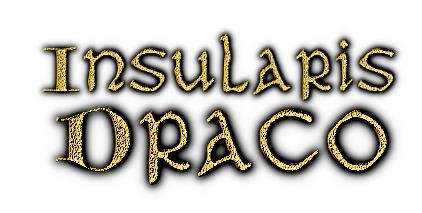FACTION OVERVIEW
Let's take a look at Insularis Draco's 31 factions, their faction icons, culture and unit roster. All except the Free Nations are playable.
BRITTONIC
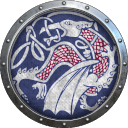
Dumnent (Kingdom of Dumnonia)
The Dumnonians start off in the South-West of Britain under King Emris (Ambrosius Aurelianus), a legendary leader (and uncle of King Arthur) who has risen up against the Pelagianist tyrant King Guorthigern (Vortigern) who leads the Council of Britain. They hold many wealthy towns and a versatile, partly romanized army. The pinnacles of Dumnonian horsemanship are the Merchic Dumnent, the bodyguards of Emris's generals. Apart from Western Britain, the Dumnonians also hold lands in Armorica, named 'Domnonea'.
![]()
Ebrauc (Kingdom of Eboracum)
The ruler of Ebrauc, Maur, is a descendant of Coel Hen, the last King of the unified Brigantes. The last vestige of Romanitas in Northern Britain, Ebrauc has a Foedus treaty with the North Angles, who help defend her shores from Pictish pirates. But can they be trusted? If not, Ebrauc's romanized, infantry-heavy military will make short work of them.
![]()
Recet (Kingdom of Rheged)
Rheged is the less-romanized, more remote sister-kingdom of Ebrauc. It carries on the Cumbrian warlike legacy of the Brigantes with decent archers, offensive spearmen and the dreaded Raven Horsemen. Rheged is less civilized, but its mountainous regions are more easily defendable.
![]()
Guened (Kingdom of Gwynedd)
The Venedotian King, Cunedag the Land-Holder, was invited to northern Cambria to drive the Goidelic settlers back into the sea. It'll be a daunting task, but when it is done, he will have access to the lucrative trade routes along the Irish Sea. Gwynedd's army is lacking in heavy cavalry due to the rocky terrain of its homelands, but the addition of longbowmen will easily make up for that.
![]()
Demet (Kingdom of Dyfed)
Dyfed is a strange, heady mixture of Brittonic and Gaelic culture. Its King Triffyn Farfog, son of an Irish Déisi settler, recently married into the local Romano-British ruling elite who were desperate for cash and military leadership in troubled times. This weird mix is reflected in Dyfed's unit roster which houses both Romanized militia, aggressive Irish pirate spearmen and javelin-throwing lancer cavalry.
![]()
Guotodin (Kingdom of the Gododdin)
The Votadini are the least Romanized Britons of the whole island, yet they still consider themselves vastly more civilized than their eternal enemies on the other side of the Firth of Forth, the Picts. Their legendary shock lancers, the White Shields, go together well with their Steady Longspearmen, who can be trusted to hold any line.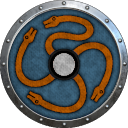
Alt Clut (Kingdom of Strathclyde)
The King of the Rock, Ceretic Land-Holder, is a man known for his pragmatic approach to the 5th century's polarized political landscape. He is, at least nominally, catholic. But he regularly raids his neighbours and even captures Irish slaves. Alt Clut's unit roster makes use of both Romanized and fundamentally Celtic concepts, exemplified by the individual fighting prowess of the longswordsmen who are nevertheless clad in the latest armour from the continent.
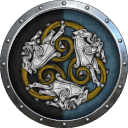
Cernou (Cornovians
When British settlers arrived in Armorica, protecting their trade interests on the continent and fleeing chaos in Britain, they intermarried with the local Armorican elite and immediately fell back into the tribal divisions of their homelands. The Kingdom of Cernou is the most powerful at the moment. It fields a decent Brittonic unit roster with varied cavalry and defensive infantry, supplemented by some Gallo-Roman specialists and its infamous Black Shield Royal Guardsmen. Their homelands in Britain are represented by the powerful clifftop stronghold of Din Tacel in modern-day Cornwall, but the center of their power lies in Brittany.
ROMANIZED
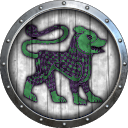
Poguis (Kingdom of Powys)
King Guorthigern (the Vortigern of Arthurian legend) is an unlucky leader. As one of the only leaders in Britain to cling to the Pelagian heresy, he is quite isolated and unpopular. Even within his own family there is discontent on the misfortunes he has brought upon the Isle of Britain, not least among them his decision to bring in Germanic foederati to defend the British cities from plundering Picts and Scotti. Luckily, Powys can call up one of the island's most versatile armies, romanized to its core and even fielding heavy horse archers, the Telu Poguis Guard!
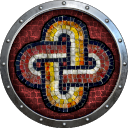
Romani (Gallo-Romans)
As one of the oldest and richest provinces of the Western Roman Empire, Gaul is well-funded and defended by multiple legions of experienced and well-equipped, professional soldiers. As long as they are not cut off from the rest of the Empire, Gaul must not fear any barbarian. However, this is exactly what seems to be happening, as the stability of the Imperium crumbles and upstart kingdoms like those of the Franks, Burgundians, Alemanni and Visigoths grow. The Romans' unit roster is incredibly varied and versatile, but it will not last for the entire duration of the campaign: in the 6th century the Romans will no longer have access to their imperial troops.
PICTISH
![]()
Uerteru (Northern Picts of Fortriu)
The Kingdom's name 'Fortriu' speaks volumes. Its lands are dotted with hillforts, earthworks and promotory fortifications. The people in these lands are warlike and distrustful of outsiders. They share some military characteristics with their arch-enemies, the Gaels of Dál Riada, but their fierce Pictish nature is represented in their lightly armoured, fast and offensive unit roster.
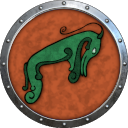
Uip (Southern Picts of Fife)
The Southern Picts are culturally closer to the Britons than their Northern kin, and their unique unit (the Maeataean Lancers) reflect that. However, Rome's influence never reached this far north, and these are Picts still. They will trade with southerners, but access to the rich cities of the eastern British coast represents a chance for plunder more than it does a trade route.
GOIDELIC![]()
Uí Néill (Line of Niall, North and South)
The Line of Niall has risen to power quickly on the heels of its legendary forefather Niall of the Nine Hostages, a mean feared from Pictland to the Alps. However, in recent years their successes have grown less frequent. Their power has made them envied and hated across the Goidelic world, and their numerous offspring will no doubt start infighting. Though not all is hopeless: their bodyguards, the Fiannamen, will literally squash any opposition who dare stand in their way.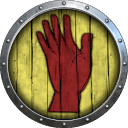
Ulaid (Overkingdom of Ulster)
The Red Branch Knights are a formidable missile cavalry unit, which guards Ulster noblemen on the battlefield. These noblemen will see a lot of battles soon, as they are the sworn enemies of the power-hungry O'Neills and are the only ones to oppose their High Kingship, save the Laigin. Perhaps Ulster will provide its own High King one day? In the mean time, the shores of Britain to the east will provide ample plunder.

Dál Riada (Kingdom of the Scotti)
The Scotti are Gaels who have been slowly colonizing the Western Isles of Alba and who will, centuries hence, give their name to Scotland itself. They have a largely unique hybrid Gaelic/Pictish unit roster, highlighting by decent British-inspired cavalry, spear-throwing Gaelic infantry and unique Oarsmen Archer Bodyguards.
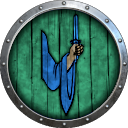
Connacht (Overkingdom of Connaught)
Connaught is a land cut off from outside influence and bereft of colonizing and/or raiding opportunities, but this isolation has enabled the Connachta to great feats of learning. Goidelic culture, Druidist and Christian alike, emanates from Connacht like the rays of the sun. One of these examples is the Goidelic Hostel building, which provides free upkeep slots, receives extra bonuses in Connacht. Its old-fashioned spear-armed soldiers, the Gamanraide, are known for their individual fighting style.
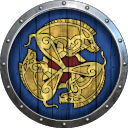
Mumu (Overkingdom of Munster)
Munster's horsemanship is famed throughout the island, and its light horsemen pester any army who dares oppose them. Munster's sights are set on southern Britain. Already their Déisi vassals have married into British nobility and taken over the kingdom of Dyfed, and soon they will start raiding in Dumnonia.
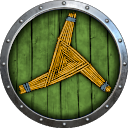
Laigin (Overkingdom of Leinster)
As the primary rivals of the O'Neills, the Leinstermen must be prepared to stand their ground against overwhelming odds. King Crimthann knows the price of defiance as his brother Eochu was the one to kill Niall himself, and was killed in revenge of course. The war between these Kingdoms will not stop soon, and to stop Loegaire Mac Niall the Leinstermen will have to pull out all the stops. Leinster is the richest and most outward-looking fifth of Ireland.
NORTH SEA GERMANIC
![]()
Ēotas (Jutes)
The Jutes were the first Germanic settlers in Britain, invited by the British King Vortigern to ward off Picts and Scots. After nearly a hundred years of pillaging, these incursions have stopped. Should Vortigern wish to send the Jutes back home he will come up against stiff resistance. The Jutes fight on foot, shield to shield, spear to spear. But if push comes to shove, they can field heavy cavalry which will frighten the sturdiest Briton longspearman.
![]()
Seaxan (Saxons in Britain)
The Saxons have only just arrived on the shores of Britain. They're not even sure they want to stay here. They were invited to this Island by Hengist and Horse, the Jutish Ethelings, but on the other side of the channel there lie many rich cities, ripe for the taking. The Saxons excel in heavy infantry. If you can break their shield-wall, you can break through anything!
![]()
Norþ-Ængle (Northumbrian Angles of Deira and Bernicia)
Like the Jutes in Kent, the tribes of Angles who settled the North of Britain were asked to defend the coastline in return for hospitality: their federacy is to the Romano-Britons of Eboracum. It is these shores who faced many Pictish raids. But the Angles will not be contained by this 'King' who pretends to be the Duke of Britain. Their otherwise infantry-heavy unit roster is complemented by light and agile shock cavalry who thrive on the blasted moors of Northumbria.
![]()
Suþ-Ængle (Southern Angles of Mercia and East Anglia)
In the preceding century, the eastern shores of Britain were so heavily plundered that they were all but completely deserted by native Britons. Into this vacuum stepped the South Angles. Their new home, the remote marshlands of East Anglia, provide an ideal isolated base from which to start their westward conquests. Within a few centuries, the Midlands and the Welsh Marches were under their control and the Kingdom of Mercia dominated all other Anglo-Saxon realms.
![]()
Sahsan (Continental Saxons)
As they watch their ambitious cousins sail across the Frisian Sea to settle Britain, the Saxons of the continent remain content: their realm is powerful, their lands are rich and their enemies are few. To their east, the friendly Frisians slowly reclaim their home from the sea. To the north, the recently deserted lands of the Angles and Jutes hold much potential. To their south, their Thuringian allies languish. It is only the power-hungry Franks about which the Saxons should be worried.
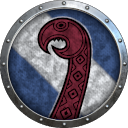
Frīsa (Frisians)
The Frisians are poised to dominate all trade which passes through the Narrow Seas on its way to Scandinavia or Aquitania. This ideal positioning will make them rich and powerful enough to rename the North Sea for themselves, the Mare Frisionum. A varied unit roster will give the Frisians a versatile army enough to give any enemy trouble, but their proximity to the ambitious Frankish kingdoms will put a damper on any overeager expanionism.
![]()
Danir (Danes of Jutland)
The Danes are perched quietly upon their peninsula, waiting for a perfect moment to strike. Let those petty kings squabble amongst themselves, they say, as we trade with them. Let them weaken each other and then, when they least expect it, our longships will land. Or bearded axes will rise and fall, and there will be no one to survive it. These Proto-Norse warriors have an abundance of offensive heavy infantry, little to no cavalry, and exquisite boatbuilding techniques. Their towns, however, are underdeveloped, and they are threatened by larger nations to their south.
CONTINENTAL GERMANIC
![]()
Saljon (Salian Franks)
If there is any of these barbarian kingdoms who have potential, it is that of the Salian Franks. During their long Foederati service for the empire these tribesmen have developed their great talent for nation building. During the chaos of early 5th century Gaul, the Salians have encroached heavily on Roman sovereignty, and yet have made themselves indispensable allies to the Empire. They hold a number of rich cities in Gallia Belgica and, thanks in part to their varied and versatile unit roster, have the potential to define the very history of Europe itself.
![]()
Ripwari (Ripuarian Franks)
The Ripuarians are the less-romanized eastern cousins of the Salian Franks. They have recently trickled down into Germania Secunda over the Lower Rhine and taken the important cities of Colonia and Bonna. It is from these urban centers that they will expand their realm outward. Their strengths lie in their Rhine-based economy, their excellent and cheap Ripuarius-ships and their strong and steady infantry.
![]()
Wistragutans (Visigothic Kingdom)
On the borders between the Regnum Tolosanum (the Kingdom of the Visigoths) and the Roman Empire lies Turones. It is on this outpost that King Thorismund has placed trusted generals, to spy around and spot weaknesses in the Provinces defences. His father Theodoric bound the Visigoths to the Empire as federates in order to defeat Attila but he died on the field and his sons have more ambition than to exist as mercenaries for an Empire on the wane. The Visigoths can field mounted archers and excellent At-Rider shock cavalry, as well as romanized infantry and laeti troops.
![]()
Duringos (Thuringians)
The Thuringians have an ideal power base in the well-defended Harz Mountains. They are surrounded by powerful and very ambitious rival tribes, however: the warlike Alemanni to their south, the Franks to their west and the Saxons to the north. The Thuringian connection to the Hunnic royal family will give them some advantages: they can bring Hunnic horse archers and lancers to battle. They will need all the outside help they can get!
![]()
Alamanni (Suebians of the Upper Rhine)
The fierce Alemanni have long been bitter enemies of the Romans. For at least two hundred years hostilities have persisted. Now the Empire has lost control of the Rhine Limes, an immensely rich region has now fallen into the eager hands of their Suebian nemeses: the Upper Rhine with its rich cities now plundered and partially in ruins. From these urbanized settlements the Alemanni can forge a kingdom to stand against their most powerful Germanic rivals, even the Franks! The Alemanni field a mainly infantry-based army of lightly armoured but aggressive warriors.
ALL CULTURES
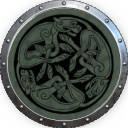
Libera Nationes (Free Nations)
